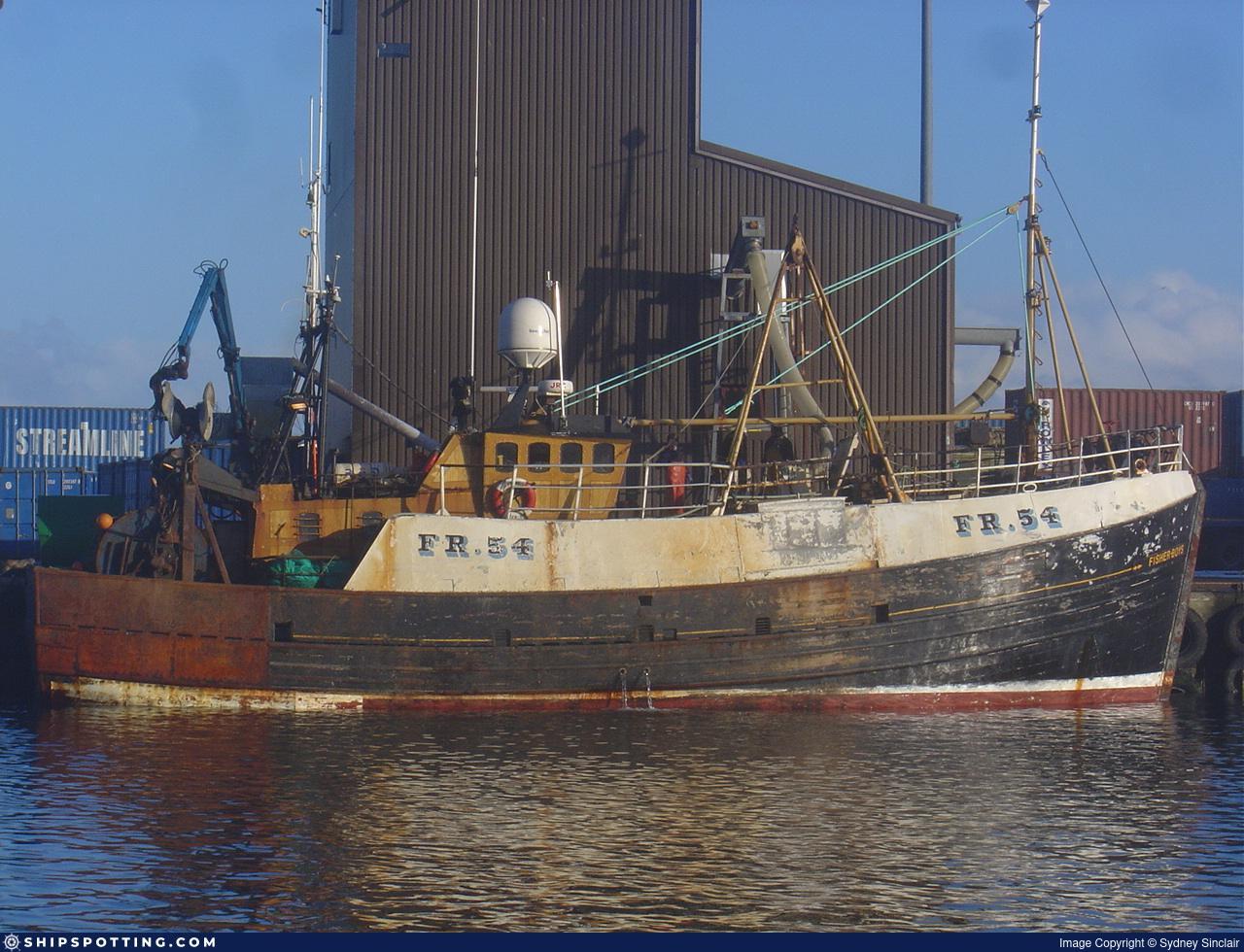
®
SHIPSPOTTING.COM
WELCOME TO SHIPSPOTTING.COM
Fisher Boys FR54
Photo
details
Photographer:Sydney Sinclair [ View profile ]
Title:Fisher Boys Fr54
Photo Category:Fishing Vessels Loa Less Than 70ft/21m
Added:Jan 11, 2008
Views:1,323
Image Resolution:1,280 x 960
Description:
Taking on ice in Lerwick Monday 6.3.06
Built 1980 Macduff Boat Building &Eng.
Length 21.31mt
Engine Kelvin TBSC8 535hp
Vessel
particulars
There is no Ship Data available for this photo!
Would you like to suggest new Ship Data?
Photo
Categories
This ship is not assigned to any other category.
More of
this ship(0)
More of:This Photographer
Got photos of this ship? Upload them now!




COMMENT THIS PHOTO(4)
To add to the record - this from the MAIB web site @ http://www.maib.gov.uk/home/index.cfm
Fisher Boys
Category: Fishing vessels
Vessel name: Fisher Boys
Registered Owner/ Manager: Fisher Boys Limited
Port of Registry: Fraserburgh
Flag: UK
Type: Twin-rig trawler
Built: 1980
Construction: Wood
Length overall: 21.31m
Gross tonnage: 152
Date & Time: 11 January 2008 1108 UTC
Location of incident: 40 miles NE Fraserburgh
Incident Type: Flooding/Foundering
Persons onboard: 5
Injuries/fatalities: 1 injury
Damage/pollution: Total loss
Synopsis
Fisher Boys arrived in Fraserburgh at about midday on 10 January 2008 from Macduff. This was the first trip after the Christmas break. Having loaded ice, the skipper moved the boat to another berth so that a repair could be carried out on his fish finder display. The skipper and crew went ashore to wait for completion of the repair and were back on board by 2000. The boat sailed at 2035. Leaving the harbour, Fisher Boys made contact with one of the piers. However, no attempt was made to check for damage, or water ingress, and the boat continued to sea.
Overnight the boat steamed towards the fishing grounds, but at about 0330 the watchkeeper noticed that the engine rpm's were dropping, and that the engine was making a strange noise. He called the skipper who decided that they should return to port to investigate the problem. At about 0700, the bilge alarm sounded. This alarm was set to sound at a level just above the top of the well in the fish hold. The skipper started the main bilge pump, which ran off the auxiliary engine. About 10 minutes later he checked the discharge and saw that no water was being pumped out. He returned to the engine room, where he dismantled the suction valve and removed a small amount of debris. Replacing the valve he found he still could not get suction, and so started a second bilge pump, which ran off the main engine. However, after running for about 10 minutes, the discharge from this pump also stopped. Inspecting the fish hold bilge, the skipper noted that the water was washing over the concrete ballast which lined the base of the hold. He also noticed that the water was running from forward through a redundant cable gland opening in the forward bulkhead. Checking the forecastle space he found that the water level here was higher than that in the fish hold, but he could not see the source of the water ingress.
He now called the rest of the crew, who had been asleep in the cabin. He told them that the boat was filling with water and that they should put on lifejackets, prepare the liferaft and get the emergency pump from the cabin. While the crew were carrying out these tasks, the skipper tried to raise the alarm, initially on VHF channel 16, then on MF 2182 kHz, and finally by pressing the DSC alert button on his radio. This was replied to by the coastguard, who then started to co-ordinate a rescue. A number of oil rig supply vessels responded, the closest being less than 30 minutes steaming away. Meanwhile, the crew used the power block to lift the liferaft from the wheelhouse roof to the poop and put on their lifejackets. However, they could not start the emergency pump as the engine had seized.
An RAF rescue helicopter and an oil rig supply vessel were soon on scene. The latter launched her FRC and took three of the crew off. Although the helicopter put two pumps on board Fisher Boys, the pumps could not cope with the water ingress. The remaining crew were taken off the boat by the FRC and transferred to the oil rig supply vessel before Fisher Boys sank at 1108.
Actions taken:
The Chief Inspector of Marine Accidents has written to the skipper reminding him of the requirement for crew to have completed all mandatory safety training courses, and drawing his attention to the advice provided in Marine Guidance Note (MGN 165(F)) titled “Fishing Vessels: The Risk of Flooding”.
The Chief Inspector of Marine Accidents has also written to the Chief Executive of the Maritime and Coastguard Agency reiterating the need to get skippers more focused on qualifications, MGN advice, and other mandatory requirements and to apply them accordingly.
Published: MARCH 2008
Regards
Steve Ellwood
Edit
comment
Edit
comment
Edit
comment
Sad to read about the loss of a vessel but thankfully the crew survived.
I found this piece on the www.thisisaberdeen.co.uk
"As reported in yesterday's Evening Express the boat sank 40 miles north of Fraserburgh. The crew sent out a mayday when the 70ft vessel began taking in water.
The signal was picked up by the Norwegian offshore supply vessel the Stril Moy.
A rescue helicopter from RAF Lossiemouth was on the scene within minutes.
Three of the crew were taken to the Stril Moy by rescue craft.
Skipper Robert Souter, from Banff, and another crewman stayed on board and tried to pump out the water.
Managing director of fishing firm Whitehills Inshore Ltd, Alec George, said: "We know it will be difficult to buy another one, because there's just no one selling their boats any more."
Regards
Steve Ellwood
Edit
comment